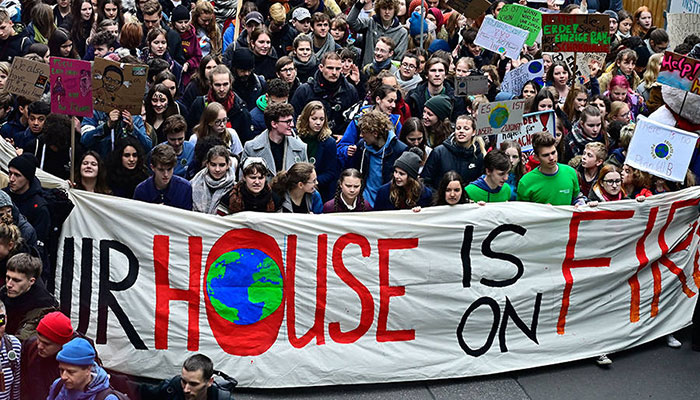Climate action: Why we strike?
Call for global strike has been inspired by Greta Thunberg, the 16-year-old climate activist from Sweden
September 20, 2019

Today, there is a global call for a strike to awaken the conscience of key actors about the imminent dangers of unabated carbon emissions and resulting climate change. Demonstrations are demanding concrete global action. Climate strikers aim at persuading and pressing political leaders worldwide that this is the right time to come up with a renewed promise to curb their carbon emissions.
This call for a global strike has been inspired by Greta Thunberg, the 16-year-old climate activist from Sweden. This Swedish teenager environmentalist has now emerged a global icon and a true champion who is credited with raising global awareness of the myriad risks posed by climate change, and withholding politicians to account for their lack of action on the climate crisis.
Today’s Global Climate Strike also named Fridays for Future, is being held three days before the UN Climate Summit in New York called by UN General-Secretary Antonio Guterres. Thus, this is undoubtedly a well-timed call for this event to create a unified global response. During the global strike, nearly 3000 events have been planned in over 115 countries across the globe.
Like numerous countries globally, there are going to be climate marches across Pakistan too. Environmentalists and concerned citizens have planned such events in most major cities today. Pakistan is a signatory to the Paris Agreement and while it does not have enough clout to force the most powerful economies to fulfil their pledges, Pakistani leadership must promote the concept of Global Public Goods: goods whose benefits extend to all countries, people and generations. Thus, Pakistan can play a proactive role at international fora to remind the largest polluters and emitters to reduce their carbon emissions for the larger benefit of humanity beyond their shores.
Although Pakistan is the sixth-largest country in the world in terms of population, it is not contributing much to climate change and global warming. According to some estimates, Pakistan emits even less than one percent of the global carbon emissions. However, it should not be implied that because of its lower carbon footprint Pakistan is resilient to climate change and is not affected by global warming. Rather, it is extremely vulnerable to climate change and global warming.
According to the Global Climate Risk Index of 2017, which ranks countries based on impacts of extreme weather events both in terms of fatalities as well as economic losses, Pakistan is among the 10 most-affected countries. Every now and then there are extremely unpredictable rainfall, recurring floods, long spells of dry weather and droughts, erratic heatwaves and outburst of glaciers. This irregular, unexpected and untimely fluctuations in weather conditions are some of the signs that Pakistan is already quite vulnerable to climate-induced hazards.
At one interval, the whole nation prays for rains when the hot and dry spell unexpectedly prolongs. This is followed by incessant rains resulting in unprecedented flooding. The 2010 monsoon flooding is a typical example that brought untold miseries. Affecting over 20 million people across the country and bringing about one-fifth of Pakistan's total land area underwater, the floods surpassed physical destruction caused by all disasters in Pakistan. The then UN secretary-general had termed the floods “the worst natural disaster” and “slow-motion tsunami”. The catastrophe was unprecedented as over 20 million people were affected, more than those affected by the 2004 Boxing Day tsunami, the October 2005 Kashmir earthquake and the 2010 earthquake in Haiti put together.
Climate change is a reality. Scientists have been warning us that the average temperature of the earth’s surface has increased 1 degree Celsius since the late 19th century. If no drastic measures are taken, there is every possibility that we will live in a much warmer planet: an increase of another 2 or 3 degrees by the end of the current century.
There is a greater responsibility on the largest economies of the world to come up with drastic initiatives. Carbon discharges from the largest economies of G20 countries are more than 90 per cent of the total global emissions. Currently, the top five polluters and carbon emission countries are China (30 per cent of the global emissions), the US (15 per cent), India (7 per cent), Russia (5 per cent) and Japan (4 per cent). These major powers must share the burden and fully abide by the Paris Agreement of 2015, where all signatories had vowed to limit global warming below 2 degree Celsius and pursue 1.5 degree Celsius. However, after the withdrawal of the Trump-led US from the climate pact in 2017, there is enormous uncertainty.
While there is a global consensus on the 17 Sustainable Development Goals (SDGs) to be achieved by 2030 and although SDG 13 specifically deals with climate change, there is also an agreement that “urgent action to halt climate change and deal with its impacts is integral to successfully achieving all SDGs”. So for achieving sustainable development and leaving a liveable planet for our coming generations, we all must play our due role in today’s Global Climate Strike.
The writer holds a PhD from Massey University, New Zealand. He teaches at the University of Malakand.
Email: [email protected]
Originally published in The News











